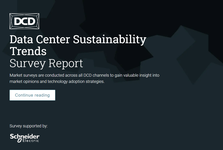Digital transformation and the growth of cloud infrastructure and services have led to exponential growth in the use of data centers. The global green data center market is expected to reach $142.8 billion by 2026 at a near 20 percent CAGR (KBV Research). For those data centers, getting it right means being able to offer robust and highly secure storage while optimizing energy efficiency to ensure low environmental impact. This is particularly critical in light of the Climate Neutral Data Centre Pact’s commitment to make data centers climate neutral by 2030. With sustainability so high on the agenda, working smarter to minimize the impact of operations and reduce carbon footprint is a key priority.
Yet for many data centers, becoming sufficiently sustainable demands a considerable rethink about how to improve operations in order to become greener. Concerns turn to the vast amount of energy used and heat generated and how to address the impact on the environment quickly. Understandably, there is mounting pressure on data centers that are not already operating in accordance with sustainable initiatives to become much more focused on meeting their green targets.
For the data center manager, the challenge is to improve sustainability while continuing to offer the best service.
Sustainable frameworks and trusted supply chains
Embracing more ethical ways of operating and demonstrating a greater awareness of the impact that positive actions can have for the environment will attract businesses with a similar commitment to sustainability. But this necessitates adherence to specific guidelines to evidence such a commitment. Working to international frameworks and standards such as the UN Global Compact can play a role in helping companies achieve the UN’s sustainability development goals (SDGs) as well as offering proof that a business is demonstrating commitment beyond mere words.
Adherence to internationally recognized frameworks speaks of shared values. With a closer focus than ever on driving cost efficiencies, accessing high-tech skills, improving service delivery, and driving innovation, the need for partnership working is key. As organizations seek closer working alliances, all stakeholders in the supply chain should be aligned around core values to build trust.
Moreover, in an age of digital transformation comes the need to protect systems from cyber attacks. With security being such a primary focus to ensure smooth, secure, and continuous operation, it is imperative that partnerships are forged with suppliers that not only understand the key concerns relating to sustainability, but can also demonstrate the highest levels of physical and cybersecurity knowledge and compliance. This might include accreditations such as ISO 27001 and Cyber Essentials Plus.
Greener surveillance cameras
Data centers use a considerable amount of power and generate high levels of heat, causing concern among green-focused data center managers. While there is no simple, quick solution, data center operatives need to be looking forensically at the systems, products, and materials used in order to make small but incremental gains towards reducing carbon footprint and achieving sustainable targets. This might include sourcing vendors for whom manufacturing with low-power consumption in mind is a priority.
For example, the use of edge-based analytics within network surveillance cameras, which facilitates the processing of video data within the device itself, allows on-camera decisions which result in a reduction in the bandwidth and power consumption that would be associated with the constant transfer of data back and forth across a network for processing. In addition, the use of dedicated technology designed to optimize camera performance while utilizing the lowest bandwidth and storage requirements further helps to support a greener business agenda.
The materials used within systems and products should also be a consideration. Data center managers should actively seek to partner with vendors whose cameras are free of BFRs and CFRs, the brominated and chlorinated flame retardants traditionally used in such devices that have been identified as toxic. In addition, the use of PVC-free surveillance solutions helps to halt the distribution of ‘microplastics’ into the environment that can sadly find their way back into the food chain.
Partnering with a trusted vendor who can demonstrate green credentials and sustainable operation helps data centers improve their sustainability posture through the use of innovative solutions that deliver the highest security with the lowest environmental impact. A sustainable approach to the manufacturing of security technology increases automation and delivers greater security while relying on fewer resources. Careful selection of materials and a commitment to the reduction of waste demonstrates that a vendor is serious about environmental responsibility through the whole chain of production. The right partner can support data centers in meeting their green targets while innovating for a smarter, safer and more sustainable world.





